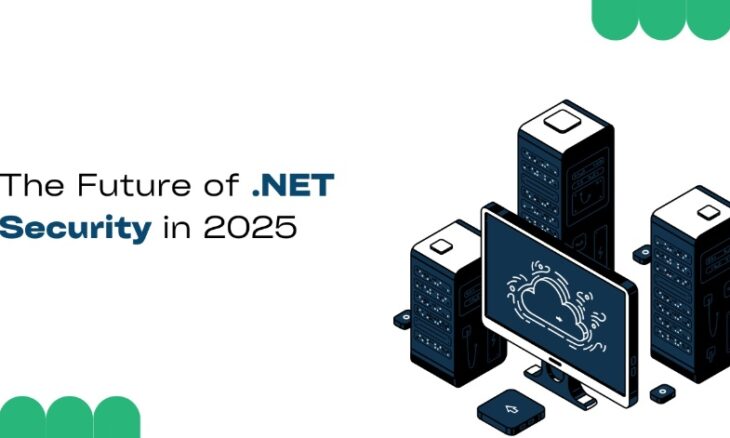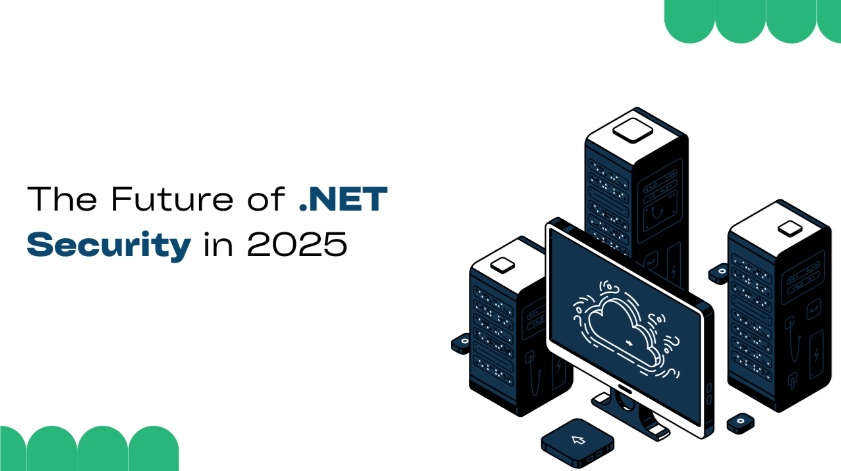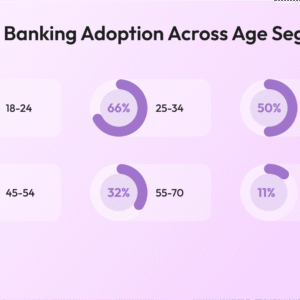
Cybersecurity is no longer a back-end problem in modern digital economy, rather a main issue in trust of a brand, regulatory compliance, and reputation of doing business. As more and more businesses and startups implement .NET to create scalable and high-performing applications, the security of these systems acquired high priority.
According to Microsoft, the .NET framework has a strong architecture, yet in 2025, a dynamic threat environment requires more than usual firewalls and encryption. This article examines the top security trends in .NET that will impact 2025 and why businesses are turning to expert .NET development services and experienced professionals who cannot only make their systems operational but also entirely secure.
Why the .NET Security Needs Focus in 2025
It uses .NET programming to drive enterprise CRM applications to healthcare and financial systems. However, with the increasing sensitivity of data and more apps moving to the cloud, there is a growing need to integrate party APIs and generally improve their attack surface.
The emergence of remote work, AI-driven attacks and tighter privacy regulations is compelling development teams to integrate security into the software development life cycle.
Companies willing to be proactive in hiring .NET developers focused on security-first positions are in a better situation to create applications that are resilient, compliant and future-proof.

1. Security-First Architecture is Becoming Important
Security is no longer an afterthought. By 2025, secure principles are implemented into the design of .NET development projects.
- Security-first architecture entails:
- Using a least-privilege rule
- Data encryption on every level
- Security-related role definition in planning
- Threat model building and compliance building
Frameworks such as ASP.NET Core even offer platforms to introduce authentication, authorization and request validation with a plug-and-play attitude. Using them properly, however, means utilizing a professional team that provides .NET development services with a special emphasis on security, which is implemented at the architectural level.
2. DevSecOps Continuous Security
DevSecOps is no longer a choice, but a standard by 2025. CI/CD pipelines are becoming a widespread practice in companies, automating security verification during the development process.
Important practices are:
- Automated vulnerability scanning of NuGet packages
- Pull request policies and secure code reviews
- Static and Dynamic analysis in build pipelines
- Management of secrets using Azure Key Vault
Incorporating security testing as part of the continuous development cycle, organizations lower risk, speed delivery, and minimize the expenditures on remediation. Intelligent enterprises employ employees. NET developers who not only program but also contribute to secure DevOps processes.
3. Azure & Hybrid Cloud-Native Security
The persisting use of Azure-based .NET applications introduces security priorities, particularly in multi-tenant, serverless and containerized application designs.
The companies are targeting:
- Azure Identity and Access Management (IAM)
- Virtual networks and firewalls through the segmentation of the network
- Vaulted key integration of app secrets, Secure SecretVault of app secrets.
- Managed service identities authentication
- Microservices role-based access control (RBAC)
As the workloads shift to the hybrid and multi-cloud, .NET development services need to be certain that they execute secure deployment plans bearing in mind cloud-specific attack vectors.
4. API Security: The Front Line of Attacks
RESTful APIs are paramount to most of the .NET applications in 2025. Regrettably, APIs have become one of the most sought-after targets for hackers as well.
The frequently encountered threats are:
- Broken authentication
- Unsafe data exposure
- Injection attacks
- Rate-limiting bypasses
Popular solutions to this include .NET teams recently implementing extremely stringent API governance through:
- JWT and OAuth2 authentication are forms of token-based authentication.
- Schema validation
- Logging API and API throttling
- Secure API gateways
That is why more companies operating at the multi-channel level hire .NET developers and rank them based on their expertise in safe API architecture.
5. AI and Analytical Intelligent Threat Detection
Since cyberattacks have become even more complicated, we can no longer rely on static security protocols. By 2025, .NET applications and infrastructure are incorporate threat detection technologies that are AI-enhanced.
Capabilities include:
- App behavior anomaly real-time detection
- User activity behavioral analysis
- Suspicious pattern predictive warnings
- The compatibility with such tools as Azure Sentinel, Defender
These smart systems are more capable of handling new threats than conventional rule-based security products. Secure coding can be combined with intelligent monitoring, enabling companies that provide premium .NET development services to be proactive rather than solely reactive, thereby minimizing mitigation efforts.
6. Smart Authentication and Passwordless Logins
A significant threat of vulnerability includes passwords. Modern identity standards feature in 2025, .NET apps will adopt the use of contemporary capabilities to reduce dependency on fixed credentials.
New authentication standards are being adopted, which are:
- Biometrics and facial recognition
- FIDO2 and WebAuthn support
- Authenticator apps based on multifactor authentication (MFA)
- SSO enterprise Azure Active Directory
Strong authentication is essential for both SaaS applications and enterprise applications. Business firms that employ .NET developers who know how to implement modern identity systems have a significant advantage in terms of security, not to mention the trust of its users.
7. Compliance-Driven Development
As the number of data protection regulations in various regions increases, including GDPR, HIPAA, CCPA, and DPDP in India, regulatory compliance is a strategic issue in 2025.
The requirements of the .NET developers have now compelled them to:
- Apply audit trails
- Record and report access to logs
- Aid in data control by the user (export/delete)
- Facilitate the acceptance of consent and policy changes
Non-adherence may result in punishment and loss of reputation. That is why compliance-by-design is emerging as an essential component of contemporary .NET development services.
8. Securing the Software Supply Chain
Contemporary .NET apps are based on third-party packages, tools, and integration. However, this level of convenience comes at the cost of exposure to breached dependencies.
To safeguard the software supply chain, programmers currently:
- Carry out regular scans of dependencies
- Counter package falsification
- Sign and verify NuGet packages
- Never go to an abandoned or unkept library
Security-conscious teams understand that an incidental external element can subsequently add vulnerabilities. This is the reason why they employ a .NET developer who adheres to good practices of package management.
9. Improved Cryptography and Post-Quantum Prep
Though full-scale quantum threats are not likely until a few years, 2025 is a turning point when companies start to plan the post-quantum cryptography replacement.
Microsoft is already integrating quantum-safe algorithms into its tools, and .NET developers can access previews for:
- Hybrid key exchange methods
- Cryptographic agility for upgrade readiness
- Enhanced TLS configurations
Future-oriented organizations are actively considering what component of their system state requires long-term, sensitive data and ensuring that their .NET base can develop accordingly.
10. Building a Culture of Security Awareness
Security-focused tools and frameworks have limited effectiveness. As of 2025, the most secure .NET environments are those where the development team is trained and updated with necessary security protocols.
Companies are funding:
- Secure coding boot camps
- Regular security audits and code reviews
- Threat modeling workshops
- Role-based access control on Git repositories
Prior to hiring developers, contractors or looking for in-house capabilities, it is always crucial to find .NET developers capable of hard coding, but capable of doing that safely. Security might be more of a consideration than technical skills.
Conclusion
.NET is set to remain one of the preferred technologies for building business-critical applications until 2025. But as software systems grow increasingly complex and the threat landscape keeps changing, security must be accepted as a basic requirement and not as an afterthought.
Basically, your application now needs ahead-of-the-basic safeguards. Modern .NET security needs to really think through identity management, secure software development, compliances, and proactive risk mitigation, along with the best tools and the best developers.
If you are thinking of financial services, a healthcare platform, or a subscription-based SaaS product, the early integration of security into the development process will go a long way in the procurement of final product and user trust.
Author Profile
- I am the owner of the blog readree.com. My love for technology began at a young age, and I have been exploring every nook and cranny of it for the past eight years. In that time, I have learned an immense amount about the internet world, technology, Smartphones, Computers, Funny Tricks, and how to use the internet to solve common problems faced by people in their day-to-day lives. Through this blog, I aim to share all that I have learned with my readers so that they can benefit from it too. Connect with me : Sabinbaniya2002@gmail.com
Latest entries
 ArticleOctober 19, 2025Why You Should Use Geo-Targeted Proxies for Web Scraping
ArticleOctober 19, 2025Why You Should Use Geo-Targeted Proxies for Web Scraping SoftwareOctober 15, 2025The Importance of Cyber Security in a Digitally Connected World
SoftwareOctober 15, 2025The Importance of Cyber Security in a Digitally Connected World BlogOctober 8, 2025The Most Recent Trends in Generative AI in the Banking Industry
BlogOctober 8, 2025The Most Recent Trends in Generative AI in the Banking Industry How ToSeptember 30, 2025How to Get Top Up Loan in MoneyView
How ToSeptember 30, 2025How to Get Top Up Loan in MoneyView